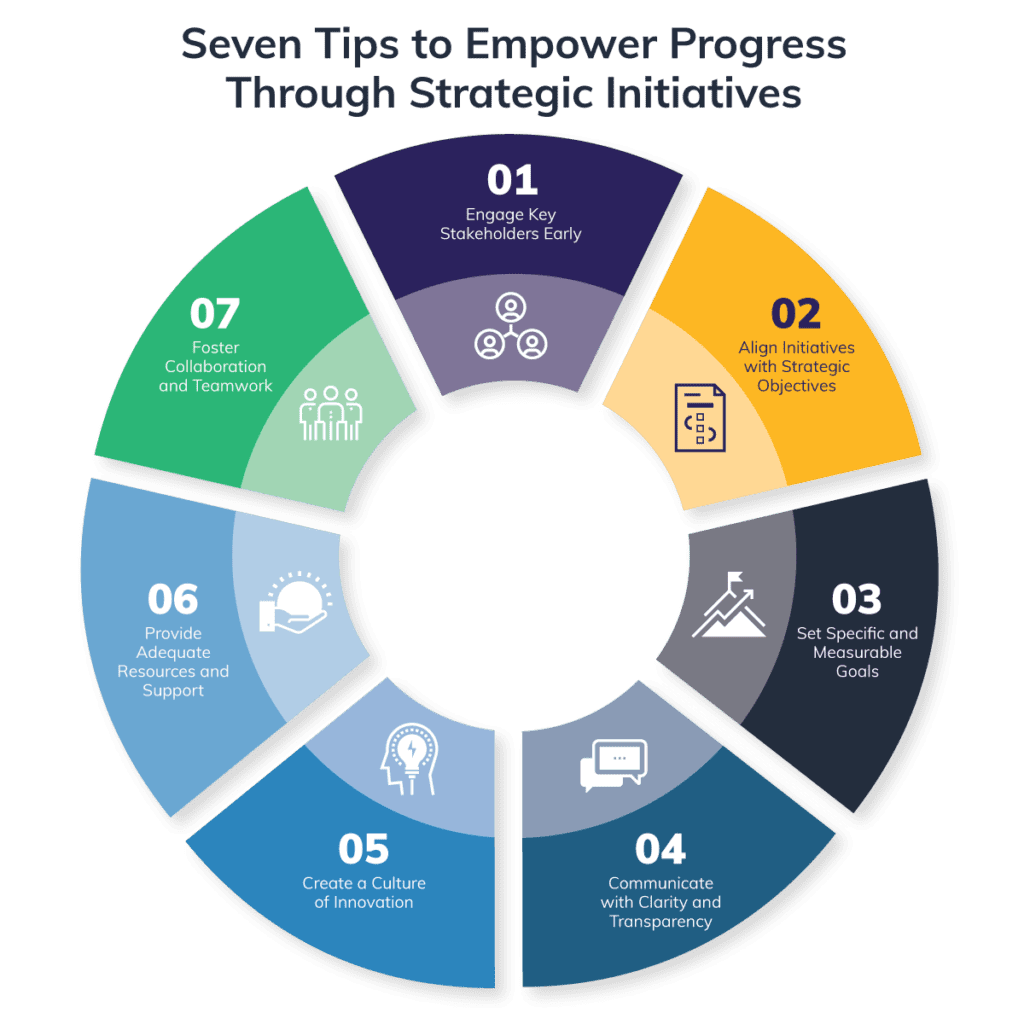In the dynamic landscape of strategic business planning, the lifeblood of success lies in the realm of strategic initiatives. These targeted and action-driven projects are the driving force that brings organizations closer to achieving their long-term vision. To ensure progress and stay on course, regular check-ins of these strategic initiatives are essential to relieve stress.
Throughout the year, it’s good practice to monitor the progress of your strategic initiatives. Whether at the beginning of the year, mid-year, or the onset of a new quarter, these evaluation points present invaluable opportunities to gauge how well your initiatives are launching and performing and whether they remain aligned with your overall strategy.
Strategic imperatives set the broad direction and priorities for the organization, while strategic initiatives represent the actionable projects and activities designed to address and fulfill those imperatives. The initiatives serve as the execution mechanisms to realize the strategic imperatives and move the organization closer to its long-term vision. We look at seven helpful tips to consider when forming strategic initiatives.
What Is a Strategic Initiative?
Before diving into strategic initiatives, it’s important to understand what a strategic initiative is and what it is not. Strategic initiatives, whether in the form of projects, programs or targeted actions, represent the actionable steps that bring a business’s vision to life. They are the tangible manifestations of strategic imperatives, carefully designed to align with the overall strategy and lead the organization towards its long-term goals.
Unlike high-level strategic imperatives, strategic initiatives delve into the details. They outline the specific actions required to accomplish strategic imperatives, leaving no room for ambiguity. Time-bound and equipped with well-defined goals and deliverables, these initiatives provide a clear roadmap for progress. Their significance lies in their ability to:
- Bridge the gap between strategic imperatives and daily operations.
- Foster alignment by aligning directly with strategic imperatives.
- Drive focus by guiding the organization to concentrate their efforts on strategic projects.
- Provide measurable milestones to track progress, celebrate successes, and take corrective action when necessary.
Why Effective Planning Includes Strategic Initiative Formation
One of the common challenges seen with strategic initiatives arises from poorly formed strategic initiatives that can impede an organization’s progress and hinder the achievement of strategic objectives. To avoid these challenges, it’s crucial for organizations to invest time and effort in developing well-defined, well-aligned, and actionable strategic initiatives that support their overall vision and strategy.
In addition, poorly formed initiatives may not align effectively with your organization’s strategic imperatives and overall strategy. This misalignment can lead to wasted resources and efforts on projects that do not contribute to the business’s desired goals.
How to Improve Initiative Formation
Articulating your company’s strategic initiatives and execution approach is the first step to enabling your teams to understand what’s changing and the why, synchronize their approach, and drive toward successful outcomes.
To help you enhance and implement your initiatives, we have seven tips we recommend considering. You can customize which you’ll prioritize, but each tip builds on each other to move toward success.
1. Engage Key Stakeholders Early
Involve key stakeholders, including leadership, department heads, and project teams, from the outset of strategic initiative formation. By seeking their input and collaboration, you can foster a sense of ownership and commitment, leading to stronger buy-in from those responsible for execution.
2. Align Initiatives with Strategic Objectives
Ensure that each strategic initiative directly supports your organization’s overall strategic objectives. Clearly articulate how the initiatives will sustain the vision and provide a roadmap for success. Aligning initiatives with strategic goals strengthens their purpose and relevancy.
3. Set Specific and Measurable Goals
Establish well-defined, specific, and measurable goals for each initiative. Achievable targets make it easier for teams to understand their responsibilities and monitor progress. When teams see the impact of their efforts, motivation and commitment rise.
4. Communicate with Clarity and Transparency
Communicate your initiatives with clarity and transparency throughout your organization. Regularly share updates, successes, and challenges to keep stakeholders informed and engaged. Open communication fosters a culture of trust and empowers teams to contribute to the initiative’s success.
5. Create a Culture of Innovation
Encourage a culture of innovation where new ideas and feedback are welcomed. Provide channels for teams, including your project management office (PMO), to share suggestions and improvements related to initiatives. Valuing diverse perspectives nurtures a sense of ownership and inspires creativity.
6. Provide Adequate Resources and Support
Ensure your initiatives receive the necessary resources, including budget, talent and technology. Work closely with the PMO. Address resource constraints proactively to enable teams to carry out their responsibilities effectively.
7. Foster Collaboration and Teamwork
Promote cross-functional collaboration and teamwork to facilitate the seamless execution of your initiatives. Break down silos and encourage interdepartmental communication to optimize overall project outcomes. Acknowledging and celebrating achievements and milestones throughout the implementation process helps to boost morale and reinforce the importance of the initiative.
Conclusion
Forming and gaining buy-in for strategic initiatives is a continuous journey that requires dedication and persistence. By engaging stakeholders, aligning initiatives with strategic objectives, setting clear goals, engaging with your PMO and fostering a culture of innovation and collaboration, you can enhance your strategic planning process and propel progress towards their organizational vision. Try tying your initiatives to business cases within your portfolio planning process to get everyone on the same page.
Together, these tips empower your organization to chart a path of success, turning strategic intent into tangible outcomes and making a lasting impact in their industries.
Embrace the power of strategic initiatives, and watch your organization thrive as it unlocks its full potential, achieves its vision, and makes a lasting mark in the competitive landscape. You can embark on a path of success, fueled by the collective determination to transform visions into reality.


